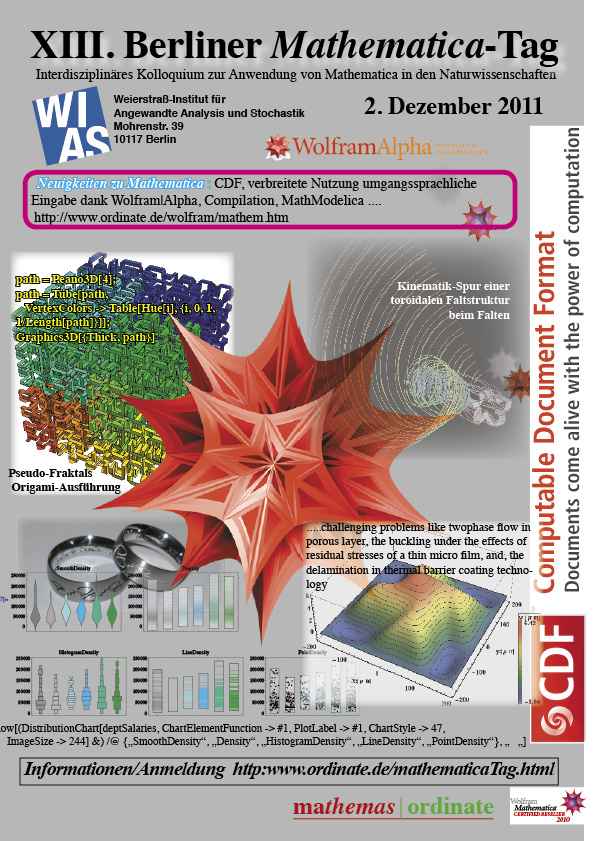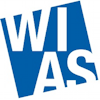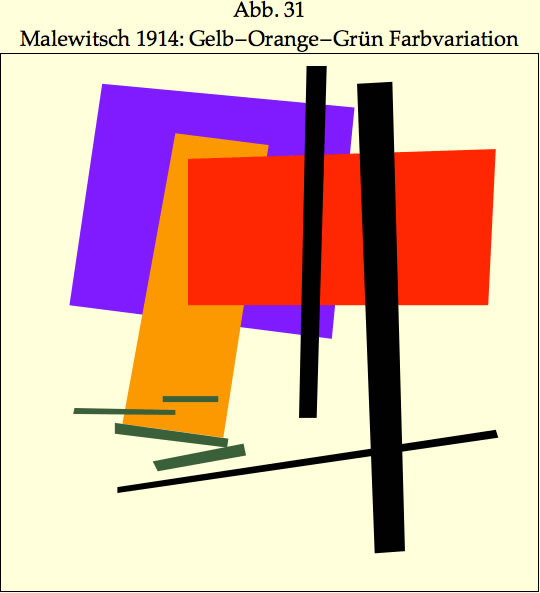 Der XIII. Mathematica-Tag Der XIII. Mathematica-Tag
 Berlin - 2.12.2011, 9:15-ca. 16:00 Berlin - 2.12.2011, 9:15-ca. 16:00
Ort: WIAS Berlin, U-Bahn Hausvogteiplatz, Erhard-Schmidt-Hörsaal (Eingang Mohrenstrasse 39)
Poster für 2011 runterladen, ausdrucken und aufhängen !
Hinweis auf IMS 2012 in London, siehe http://www.InternationalMathematicaSymposium.org
Programm - Änderungen auch kurzfristig vorbehalten
9.15 Begrüssung
9.30 Dr. Oliver Rübenkönig, Wolfram Research
Aktuelles und Entwicklungen (Arbeitstitel)
10.30 Dr. Yasser SAFA, Institute of Computational Physics, Zurich University of Applied Sciences:
Mathematica Implementation of New Simulation Codes for Challenging Industrial Applications
A short overview on new numerical codes recently implemented in Mathematica is introduced with selected examples of results for challenging problems like two phase flow in porous layer, the buckling under the effects of residual stresses of a thin micro film, and, the delamination in thermal barrier coating technology.
In the main part of this talk the implementation of a new method to study the transport phenomena under specific geometrical constraints is shown. The local reactive flow in an industrial domain of special geometry still is an important topic in numerical simulation. For example, the problem of high aspect ratio between length and thickness of the thin layer requires a smooth mesh generation to avoid the badly conditioning system resulting from stretched element. The classical solution of convective dominant transport is usually stabilized by an added numerical diffusion which lead to an inaccurate representation of the boundary layer. The nonlinear conservation system is usually solved by means of linearization methods like NewtonRaphson which is not always efficient in the case of badly conditioning problems. In SOFC fuel cell applications, unlike conventional methods, the ADI (Alternating Direction Implicit) numerical scheme allows one to predict local gradients of chemical species and electrical charges with low computing costs and unconditional numerical stability. This is especially important in the vicinity of a current collector rib and under extreme operation conditions, e.g. when the fuel gets depleted. Furthermore, the convection dominant transport within the gas distribution channels has been accurately calculated without using an additional transversal (artificial) numerical diffusion.
Important results are obtained from Mathematica programing to be relevant for the industrial applications.
11.30 Dipl.-Ing. Yves Klett, IFB Institut für Flugzeugbau, Universität Stuttgart:
Mathematica für Ingenieure (Fallbeispiele)
While mechanical engineers certainly are responsible for huge amounts of computation, their approach to doing math can be somewhat practical: They need some way to get things done (and please, no metaphysical debates about error representations of floating point numbers, because there in fact is a deadline for this car/airplane/rocket/toaster crash test).
Especially in R&D one is faced with any kind of everchanging tasks involving dirty realworld processes that obstinately refuse to behave according to theory (and sometimes depend more on the day of the week and the weather than on calculation), but still need to be dealt with.
Thus the box of chocolates analogy: Sometimes you really don¥t know what you¥re gonna get - but you better get it done ¥til next week, thank you very much, chop-chop. On the plus side, no one is going to fire you because you used a horribly inefficient root finding method (as long as it works, that is).
Because many of those tasks do involve really non-standard problems and processes, you need a flexible, rapidly deployable tool. As it turns out, Mathematica does exceptionally well here. We¥ll present a few select examples where we make particularly good use of Mathematica in everyday (and not so everyday) research, ranging from test data analysis to computational origami.
12.15 Imbiss-Pause (Spende von mathemas ordinate, bereitet von WIAS)
13.15 Dipl.-Ing. Yves Klett:
Computational Origami (mit Mathematica)
Lightweight construction is of paramount importance for the design of aircraft and rockets, but also for everything that needs to be moved around quickly and efficiently, including stuff like cars, bicycles and hard-disk writing heads.
One way to build light is to make the best possible use of already available material by using certain universal construction principles, one of these being the Sandwich Principle.
Paper can be used to produce high-performance structures, like e.g. the well-known hexagonal honeycombs - or so-called MIO (Modular Isometric Origami) foldcores that are folded in one step from one piece of paper without stretching, cutting or gluing. We'll show why it is a good idea to harness origami principles to manufacture innovative lightweight cores with multifunctional properties.
To get a grip on the special properties of 1DOF (one degree of freedom) folded structures, it is necessary to develop software that allows to build virtual unit cells and derive and simulate their kinematics. Mathematica is an excellent tool to do so, because algebraic and numerical methods can be applied in a combined fashion, and the results can be visualized and manipulated in real time. We'll show some examples on the workflow that not only covers design and simulation, but also prototyping and quality control.
13.45 Carsten Herrmann, mathemas ordinate:
Anmerkungen zu „large scale systems modeling“, Simulation und vernetzte Manipulates
Was könnte es sein/werden ?
14.00 Dr. Axel Kilian, Hochschule Merseburg:
Newton-Fraktale mit Mathematica
Newton-Fraktale entstehen, indem man einen Teil der Gaußschen Zahlenebene rastert und die Punkte als Startpunkte eines Newton-Verfahrens durchläuft. Die daraus gewonnenen Informationen, nämlich welche Nullstelle gefunden wurde und wie viele Schritte dafür benötigt wurden, werden mit einem geeigneten Farbschema als Rastergrafik visualisiert. Besitzt die untersuchte Funktion mehr als zwei Nullstellen, tritt ein erstaunliches Phänomen auf: die Grenze zwischen den Bereichen, in denen das Verfahren entweder zur einen oder zur anderen Nullstelle strebt, ist keine einfache Linie, sondern ein Fraktal.
Nach einer kurzen Einführung in die fraktale Geometrie wird anhand von auserlesenen Beispielen demonstriert, dass jede Funktion, quasi als Signatur, ihr ganz spezielles Newton-Fraktal besitzt. Die Tools zur Erzeugung und Visualisierung wurden vollständig in Mathematica implementiert.
14.30 Patrick Scheibe,
Translationszentrum für regenerative Medizin, Universität Leipzig: „Ring-Desing mit Mathematica“
Heutzutage ist vieles möglich; unter anderem auch, mit einem Laser vollkommen frei wählbare Grafiken in Metalle einzubrennen. Warum sich also nicht mit Mathematica ein völlig einzigartiges Muster für die Eheringe erstellen? Und wenn man gleich dabei ist, warum nicht gleich den ganzen Ring modellieren, um eine Vorstellung vom Endprodukt zu bekommen? Wie das geht, wird im Vortrag erklärt.
15.00 (falls noch Zeit ist)
Rolf Sulanke, Prof. Dr. , (Humboldt-Universität Berlin)
Möbius Geometrie mit Mathematica
Möbius Geometrie behandeln wir hier als die konforme Geometrie der dreidimensionalen Sphäre. Um sie mit Mathematica zu bearbeiten, sind Erweiterungen des begrifflichen Apparats nötig, die interessante Anwendungen auch in anderen Gebieten ermöglichen: 3D-Kreise und Sphären in der euklidischen Geometrie, pseudo-euklidische lineare Algebra mit einem Orthogonalisierungsverfahren, und die Korrespondenz von Objekten der dreidimensionalen Möbius Geometrie zu Objekten des pseudo-euklidischen fünfdimensionalen Vektorraums. In diesem Vortrag kann ich nur einige Beispiele für die Anwendung dieser Erweiterungen in der Mobius Geometrie vorstellen. Das gesamte Material einschließlich der Mathematica Notebooks und Packages kann man von meiner Homepage http://www-irm.mathematik.hu-berlin.de/~sulanke/ herunterladen.
Univ.Prof. Dr. em. Götz Uebe, (HSU Hamburg)
Kunst, Geometrie und Zufallszahlen
Following the well known cliché, that modern abstract art has been a revolutionary act to create, yet is often easily be simulated by machine, we look at some specific elementary schemes of 'computer' art. By employing the uniform random number 'RandomReal[ {a,b}]' of Mathematica, and using a set of basic geometric figures (lines, squares, etc) surprisingly pleasing fake artists' collections can be generated, and can be easily generated. These fake art results recall the works of well known artists as Josef Albers, Blinky Palermo, George Korsmit, Piet Mondrian, Georg Nees, Bridget Riley, Victor Vasarely, Damien Hirst, Herman de Vries and many others. Obviously there are parallel spheres of statistics and art, both using randomness and repetition. Examples are presented.
Anschliessend Kaffee-Pause und Ausklang
Bei Fragen : carstenAtOrdinateDE oder Tel.: 0431 2374500 oder 0177 3128557
|

